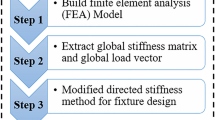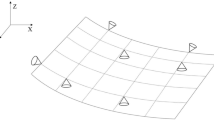Abstract
In order to reduce the deformation and assembly error in an antenna thin wall parts assembly process, the assembly location or clamping positions need to be optimized. In this paper, the effect of clamping positions and clamping force on the thin wall parts deformation is analyzed considering the gravity by finite element simulation under different clamping force. The clamping positions are optimized with the Adaptive Simulated Annealing (ASA), Multi-Island Genetic Algorithm (MIGA) and Particle Swarm Optimization (PSO) algorithm by Isight software to reduce the deformation. Comparing with MIGA and PSO method, the results show that the clamping position optimization based on ASA exhibits the better results and superior than the MIGA and PSO no matter whether it has the effect of gravity. Simultaneously, through establishing the contact force model and contact deformation model, the nonlinear relationship between contact force, contact deformation and contact area is qualitatively analyzed, and the node deformation is calculated by theoretical formula. Comparing with those results, it is shown that the theoretical value matches well with the simulation results. Finally, some clamping scheme principles are proposed so that it provides a basis for reducing the deformation and assembly error of thin wall parts in future.
Similar content being viewed by others
References
Krishnakumar, K. and Melkote, S. N., “Machining Fixture Layout Optimization using the Genetic Algorithm,” International Journal of Machine Tools and Manufacture, Vol. 40, No. 4, pp. 579–598, 2000.
Kulankara, K., Satyanarayana, S., and Melkote, S. N., “Iterative Fixture Layout and Clamping Force Optimization using the Genetic Algorithm,” Journal of Manufacturing Science and Engineering, Vol. 124, No. 1, pp. 119–125, 2002.
Jin, J. and Shi, J., “State Space Modeling of Sheet Metal Assembly for Dimensional Control,” Journal of Manufacturing Science and Engineering, Vol. 121, No. 4, pp. 756–762, 1999.
Wang, M. Y. and Pelinescu, D. M., “Optimizing Fixture Layout in a Point-Set Domain,” IEEE Transactions on Robotics and Automation, Vol. 17, No. 3, pp. 312–323, 2001.
Tan, E. Y. T., Fuh, J. Y. H., Nee, A. Y. C., “Modeling, Analysis, and Verification of Optimal Fixturing Design,” Automation Science and Engineering, IEEE Transactions on, Vol. 1, No. 2, pp. 121–132, 2004.
Prabhaharan, G., Padmanaban, K., and Krishnakumar, R., “Machining Fixture Layout Optimization using FEM and Evolutionary Techniques,” The International Journal of Advanced Manufacturing Technology, Vol. 32, Nos. 11–12, pp. 1090–1103, 2007.
Padmanaban, K., Arulshri, K., and Prabhakaran, G., “Machining Fixture Layout Design using Ant Colony Algorithm based Continuous Optimization Method,” The International Journal of Advanced Manufacturing Technology, Vol. 45, Nos. 9–10, pp. 922–934, 2009.
Chen, W., Ni, L., and Xue, J., “Deformation Control through Fixture Layout Design and Clamping Force Optimization,” The International Journal of Advanced Manufacturing Technology, Vol. 38, Nos. 9–10, pp. 860–867, 2008.
Liao, Y. G., “A Genetic Algorithm-based Fixture Locating Positions and Clamping Schemes Optimization,” Proceedings of the Institution of Mechanical Engineers, Part B: Journal of Engineering Manufacture, Vol. 217, No. 8, pp. 1075–1083, 2003.
Selvakumar, S., Arulshri, K., Padmanaban, K., and Sasikumar, K., “Design and Optimization of Machining Fixture Layout using ANN and DOE,” The International Journal of Advanced Manufacturing Technology, Vol. 65, Nos. 9–12, pp. 1573–1586, 2013.
Xiong, L., Molfino, R., and Zoppi, M., “Fixture Layout Optimization for Flexible Aerospace Parts based on Self-Reconfigurable Swarm Intelligent Fixture System,” The International Journal of Advanced Manufacturing Technology, Vol. 66, Nos. 9–12, pp. 1305–1313, 2013.
Liu, Z., Wang, M. Y., Wang, K., and Mei, X., “Multi-Objective Optimization Design of a Fixture Layout Considering Locator Displacement and Force-Deformation,” The International Journal of Advanced Manufacturing Technology, Vol. 67, Nos. 5–8, pp. 1267–1279, 2013.
Abedini, V., Shakeri, M., Siahmargouei, M. H., and Baseri, H., “Analysis of the Influence of machining Fixture Layout on the Workpiece’s Dimensional Accuracy using Genetic Algorithm,” Proceedings of the Institution of Mechanical Engineers, Part B: Journal of Engineering Manufacture, Vol. 228, No. 11, pp. 1409–1418, 2014.
Qin, G., Zhang, W., and Wan, M., “Analysis and Optimal Design of Fixture Clamping Sequence,” Journal of Manufacturing Science and Engineering, Vol. 128, No. 2, pp. 482–493, 2006.
Siebenaler, S. P. and Melkote, S. N., “Prediction of Workpiece Deformation in a Fixture System Using the Finite Element Method,” International Journal of Machine Tools and Manufacture, Vol. 46, No. 1, pp. 51–58, 2006.
Lu, C. and Zhao, H.-W., “Fixture Layout Optimization for Deformable Sheet Metal Workpiece,” The International Journal of Advanced Manufacturing Technology, Vol. 78, No. 1–4, pp. 85–98, 2015.
Deng, H. and Melkote, S. N., “Determination of Minimum Clamping Forces for Dynamically Stable Fixturing,” International Journal of Machine Tools and Manufacture, Vol. 46, No. 7, pp. 847–857, 2006.
Cai, W., Hu, S. J., and Yuan, J., “A Variational Method of Robust Fixture Configuration Design for 3-D Workpieces,” Journal of Manufacturing Science and Engineering, Vol. 119, No. 4A, pp. 593–602, 1997.
Li, B. and Melkote, S. N., “An Elastic Contact Model for the Prediction of Workpiece-Fixture Contact Forces in Clamping,” Journal of Manufacturing Science and Engineering, Vol. 121, No. 3, pp. 485–493, 1999.
Li, B. and Melkote, S., “Fixture Clamping Force Optimisation and Its Impact on Workpiece Location Accuracy,” The International Journal of Advanced Manufacturing Technology, Vol. 17, No. 2, pp. 104–113, 2001.
Asante, J. N., “A Combined Contact Elasticity and Finite Elementbased Model for Contact Load and Pressure Distribution Calculation in a Frictional Workpiece-Fixture System,” The International Journal of Advanced Manufacturing Technology, Vol. 39, Nos. 5–6, pp. 578–588, 2008.
Xiong, C.-H., Wang, M. Y., Tang, Y., and Xiong, Y.-L., “On the Prediction of Passive Contact Forces of Workpiece-Fixture Systems,” Proceedings of the Institution of Mechanical Engineers, Part B: Journal of Engineering Manufacture, Vol. 219, No. 3, pp. 309–324, 2005.
Author information
Authors and Affiliations
Corresponding author
Rights and permissions
About this article
Cite this article
Pan, Mh., Tang, Wc., Xing, Y. et al. The clamping position optimization and deformation analysis for an antenna thin wall parts assembly with ASA, MIGA and PSO algorithm. Int. J. Precis. Eng. Manuf. 18, 345–357 (2017). https://doi.org/10.1007/s12541-017-0042-3
Received:
Revised:
Accepted:
Published:
Issue Date:
DOI: https://doi.org/10.1007/s12541-017-0042-3




